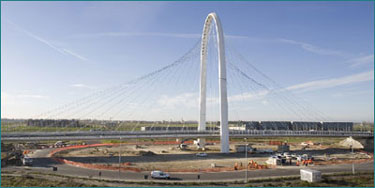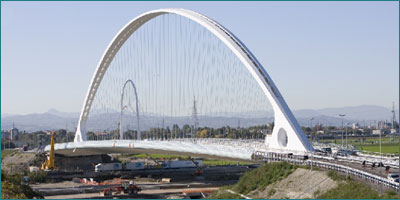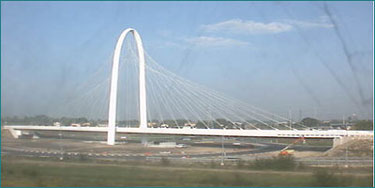Architect Santiago Calatrava's Bridges
Address and contacts
Viale dei Trattati di Roma - 42124 Reggio nell'Emilia 0039 0522 456474 - Policies for economic development and internationalization
![]() emily.corradini@comune.re.it
emily.corradini@comune.re.it GiraReggio
Description
The three bridges are part of the redevelopment and development project of the northern area started by the Municipality of Reggio Emilia on the occasion of the passage of the High-Speed Railway line on the territory and the choice of Reggio Emilia as the only stop between Milan and Bologna.
In 2002 the Municipality of Reggio Emilia identified the Spanish architect Santiago Calatrava as the designer of an intervention on an urban scale that combined the needs of the territory and the quality of the intervention.
The urban redevelopment proposal, presented by the Spanish architect and then approved by the Tav project, envisaged, in an area of two square kilometers, the design of a series of infrastructures representing the new access gates to Reggio Emilia: the High Speed Mediopadana Station, the coverage of the new motorway tollbooth and the three bridges along the new equipped road that connects Reggio to the Lower Emilia region.
Reggio Emilia is the only European town that hosts a complex of three bridges designed by the Catalan architect.
The works, carried out in five years at an estimated cost of 46 million Euros, are an extraordinary "brand" for the town and the region, a symbol of "mobility", typical of an area that has always been dedicated to trade, social and economic relations, meetings among different cultures.
Their charm will be enhanced, at night, by lighting powered with clean energy, from renewable sources and based on a specific plan to avoid energy dispersion.
South bridge
Along the new ring road that connects Reggio Emilia to the town of Bagnolo in Piano, on the roundabout of the motorway junction, is the South bridge, a bridge with an arched pylon, 70 metres high, orthogonal to the direction of travel of the cars.
The main structure is divided into exposed support abutments, a deck consisting of a central caisson and lateral ribs and stays.
The bridge, 179 metres long and 15 metres wide, is made entirely of white-painted steel, except for the two reinforced concrete abutments.
It is a cable-stayed bridge, whose stays (steel cables) make up an unusual shape, like a branch of hyperbola.
Central bridge
Continuing to north, you go up the central bridge overpassing the A1 motorway and the High-Speed line which is the key element in terms of planimetric position and size.
In this case, it is a 'push-out' bridge in white-painted steel with a clear span of 221 metres and 50 metres high, consisting of two side abutments in exposed reinforced concrete, a deck supported by a "spine”, consisting of a central caisson to which the ribs on which the cars pass are welded, and a large arch with an octagonal section placed in a longitudinal direction.
The connection between the deck and the arch is made by means of 50 pairs of steel cables.
The bridge is structured in two lanes in each direction with traffic dividers and cycle-pedestrian lanes protected in laminated glass, for an total road platform width of almost 27 metres and for a total weight of 4,000 tons of fully welded steel.
North bridge
The sequence of bridges ends up with the north bridge, structurally and architecturally identical to the first.
The equipped axis, as mentioned, serves the new motorway exit, another major gateway from and to the town, whose roof is an integral part of the Calatrava urban project.
The structure, with a total height of 50 metres, is composed of two inclined pylons, a steel and glass canopy, 56 ribs and 52 stays, which generate an inverted arch shape.
For people arriving in Reggio Emilia from the motorway, the perspective design of the toll booth and the south bridge gives rise to a very particular composition, thanks to a careful study of the scenographic impact of the works.
Since the Renaissance Reggio Emilia has entrusted its image to a new monument, it has decided to tell its story through a new work that could synthesize its drive towards modernity.
Now those projects and ambitions are 'signs' of our territory. Looking at the urban landscape of the town, we can identify some works that tell Reggio Emilia of the previous eras, and are a constant part of our daily life.
In the XVI century the town built the San Prospero Church in memory of its patron saint and protector.
In the XVII century the town built the Ghiara Church as a sign of religious devotion, and in the XVIII century the Rivalta royal palace was predominant with its aristocratic monumentality.
In the XIX century the Municipal Theatre represented the figure of the skill of the bourgeoisie, in the XX century the Officine Reggiane outlined the economic scenario of our territory.
Today it is the bridges of architect Santiago Calatrava that perform this function of synthesis and become a symbol of contemporaneity.
It is the large arches that describe the postmodern flow that "build a bridge" to the future of the town and express its vocation to continually redesign itself within rapidly changing scenarios.
Santiago Calatrava, the designer of the bridges, imagined these works with both a functional and symbolic value, as signs that mark the territory:
"Bridges are seen by more than one hundred thousand people in just one day ... I therefore wanted to introduce structures that, beyond mere functionality, would assume a symbolic character".
"The bridges of the equipped axis have the symbolic ability to become a gateway both longitudinally and transversely".
"Beyond pure functionality, I wanted to create a sign that would give a more local sense to the work ... this eye in the shoulder of the bridge was not necessary, but it recalls the rose window of the Reggio Emilia Cathedral, and it seemed interesting to create a connection with an architectural and monumental element of the town".
“The landscape of the Po River Valley is basically flat and green. Every so often trees or a bell tower emerge standing out against a blue sky. It was necessary to develop elements giving life to the place: arches, semi-arches, waves, so as to create distinctive signs on the territory".
(Santiago Calatrava Valls Calatrava Lectio 2005).









